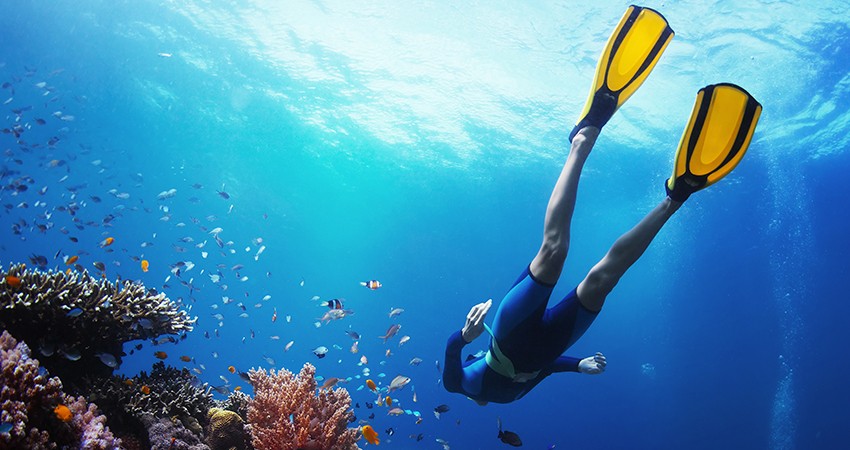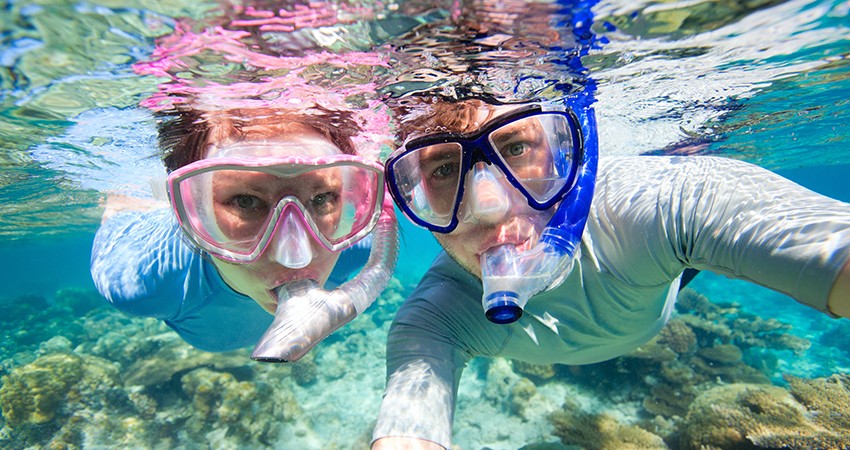Diving Sites in Port Blair







Skin diving is snorkelling while making breath-hold dives for observing aquatic life. If you are unable to scuba dive or if scuba diving is not your thing, then you can simply skin dive to explore the underwater world. In this course, you will learn to explore aquatic life by comfortably venturing under the water for short visits. You can dive in a freshwater lake or an ocean at a dive destination on holiday or near your home.
One must be at least eight years old for enrolling in a PADI Skin Diver course. No prior experience is required. However, you need adequate swimming skills and comfort in the water.
Download Medical FormPADI Skin Diver is a beginner course wherein you learn snorkelling and skin diving techniques. Your instructor will teach you the following:
- Checking buoyancy
- Surface swimming
- Clearing water from your snorkel
- Performing effortless surface dives
Academic
The PADI Skin Diver course will teach you the following:
- Going on an optional skin dive at a local dive site
- Choosing, adjusting, and using skin diving equipment
- Basic safety guidelines for being in and around the water
- Snorkelling and skin diving skills such as checking buoyancy, surface swimming, clearing water from the snorkel, and performing effortless surface dives
Become a Certified Scuba Diver – Join Our Course Today!
Equipment
During this course, you will be taught how to use basic snorkelling equipment including a mask, fins, snorkelling vest, snorkel, wet suit, and dive weights as required. The PADI professional will teach you about the gear you will need for this diving course and will clarify any other doubts you have.
Getting started
To learn skin diving and get certified, you can enrol in a local PADI dive centre or resort. Your instructor will also tell you about the PADI Discover the Underwater World video and companion piece– The Snorkeler’s Field Guide. The video has great tips that will help you when you go under the water. The field guide will give you knowledge about different underwater environments as well as common aquatic life.
Myriad of marine life in the Andamans
If you are a nature lover along with an adrenaline junkie as well, then you should know that the Andaman Islands is the best places for diving across India. Your trip to this island would be incomplete without a dip in its serene waters that is oozing with rich marine life. Its marine life is world-famous and thus, considered perfect for scuba diving and snorkelling. Swimming freely in the blue ocean surrounded by colourful corals and a variety of fish is something that you will not forget ever. It’s like swimming in a huge aquarium. Interesting, isn’t it! Especially for divers, the biggest reason to travel to Havelock Island is to witness the majestic aquatic creatures that swim peacefully in the azure waters.
The Andaman Islands are ranked at a pretty high position when you search for the best scuba diving destinations across India. The perfect conditions for a growing underwater world are provided by the sparkling and warm waters of the Indian Ocean. Its thriving marine life includes a wide variety of incredible fish and corals.
If you are someone who is willing to partake in a bit unusual dives, then go for night dives, deep dives, and wreck dives. You can scuba dive all year round, but the best time is between October and May when the water is clearer and calmer. That’s why everything may get extra costly here during the peak season.
However, if you are not confident enough to go scuba diving but are willing to explore the beautiful underwater world, then you should go for snorkelling or skin dive. Dive Andaman will give you the required diving equipment and you can purchase it as well. You will also be provided flippers that help you to swim in the ocean. But you really have to be very careful that you never accidentally step on the living corals as the ecosystem is very delicate here.
Dive Andaman also provide boat trips wherein you stop at the most popular snorkelling or skin diving hotspots. These often include a mouth-watering lunch or a sunset dinner as well. Clicking underwater photographs is highly recommended. So you can bring along a waterproof GoPro to capture the wonderful marine life in your camera or ask its staff for the same.
About Dive Andaman
If you are in the Andaman Islands and are willing to enrol in the Skin Diver program, then trust none other than the best–Dive Andaman. Located in Havelock Island (officially known as Swaraj Dweep now), this 5-star PADI center is a renowned dive shop that offers all kinds of diving programs designed for beginners as well as experienced, along with recreational dives as well. Whether you want to go shore diving or boat diving, its diving professionals will make sure that you get exactly what you want.
It's absolutely fine even if you don’t know swimming. There are fun dives for which Havelock Island is very popular. You will be accompanied by your instructor under the water at all times and he will make sure that you feel safe. Scuba diving is the best way to explore the underwater world and it requires some level of familiarity with the water. Make sure that you go for it with a PADI-certified dive shop, especially if it is your first dive.
At Dive Andaman in Havelock Island, you can enrol in various programs and dives as per your preference. It is absolutely fine if you have never ever dived in your life. Its trainers are experts in teaching newbies. They often have special training pools where you are taught the techniques so that you can get comfortable with being under the water and feel familiar before going out for the actual dive. There is a lot on offer for more advanced divers. All you have to do is show your PADI certification to the dive centre when you arrive and make the most of the island.
Happy diving!
Frequently Asked Questions
-
Q. 1 : What kind of diving courses should you take to be a recreational scuba diver?
You need to train at a diving centre to be a recreational diver. You will start with an open-water scuba certification. Thereafter, you can get an advanced Open Water Scuba certification, Rescue certification, and then a Master Scuba Diver certification. To become a professional scuba diver, you need to start from the Master Scuba Diver level. You can become an assistant at a diving centre to learn the professional side of scuba. Thereafter, you need to take an open water scuba instructor course, that trains you to be an instructor as well as certify others. Going forward, you can become a Master Scuba Diver trainer.
-
Q. 2 : What is the PADI Skin Diver Course?
Answer: The PADI skin diver course is a short introductory course that focuses on the basic skills and safety procedures needed to enjoy skin diving. Skin diving is a form of underwater diving that involves swimming on the surface of the water while holding your breath. It is typically done with minimal equipment such as a mask, snorkel, fins, and a wetsuit. Skin diving lets you explore the underwater world without the need for scuba equipment, making it a popular recreational activity. Upon completion of the skin diver course, you will receive a PADI Skin Diver certification, which will allow you to skin dive in areas within your skill level and without the need for scuba equipment.
-
Q. 3 : Do you need experience in scuba diving to pursue a PADI Skin Diver course?
Answer: The skin diver course is for beginners. So, you don’t need any prior experience to pursue the course. Anyone who is comfortable in the water and can swim can enrol in the course. Swimming is mandatory as skin diving involves swimming and floating on the surface of the water while wearing a mask, fins, and snorkel. It is important to be comfortable in the water and be able to swim to enjoy skin diving.
-
Q. 4 : What will I learn in the PADI Skin Diver Course?
Answer: The PADI skin diver Course covers the basic skills and techniques needed to enjoy the underwater world safely. The course includes classroom sessions and practical sessions in the water. During the course, you will learn about the equipment used in skin diving, the proper techniques for breathing through a snorkel, and the basic skills needed to navigate underwater.
-
Q. 5 : How long does the PADI Skin Diver Course take?
Answer: The PADI skin diver Course typically takes half a day to complete. The course includes a classroom session where students learn the basic principles of skin diving, followed by a practical session in the water where they practice the skills they learned in the classroom. The duration of the course may vary depending on the individual's learning pace and comfort level in the water. However, with the guidance of a PADI-certified instructor, students can expect to gain the knowledge and skills needed to enjoy skin diving safely in just a few hours.
-
Q. 6 : Is there an age limit for the PADI Skin Diver Course?
Answer: The skin Diver program is open to anyone who is comfortable in the water and can swim. But anyone younger than 8 years is usually not allowed to do any diving-related activity. Also, children under the age of 10 may need to be accompanied by an adult during the course.
-
Q. 7 : What kinds of equipment do you need to do a PADI skin diver course?
Answer: To participate in the course, you will need basic equipment such as a mask, snorkel, fins, and a wetsuit. It is important to choose equipment that fits you well and is comfortable to wear. Most diving centres in Andaman and Nicobar Islands offer equipment rental, but if you plan on doing skin diving frequently, it is recommended to invest in your equipment. A well-fitted mask and snorkel are essential for clear vision and easy breathing, while fins help you swim efficiently and conserve energy. A wetsuit provides thermal protection and helps you stay comfortable in the water.
-
Q. 8 : What is the cost of the PADI Skin Diver Course in the Andamans?
Answer: The cost of the skin diver program varies depending on the location and dive shop offering the course. In Andaman and Nicobar Islands, the cost of the course is typically around INR 3,000-5,000 per person. This may or may not include equipment rental and certification fees, so it is important to check with the dive shop beforehand to get a full understanding of the costs involved.
-
Q. 9 : Where can I take the PADI Skin Diver Course in Andaman and Nicobar Islands?
Answer: Andaman and Nicobar Islands are home to some of the most beautiful and diverse marine life in the world, making them a popular destination for skin diving enthusiasts. Some popular skin-diving sites in Andaman and Nicobar Islands include Havelock Island, Neil Island, and South Button Island. The beaches of Havelock Island are known for their crystal-clear waters and vibrant coral reefs, making it a popular destination for skin diving. Likewise, Neil Island is home to several beautiful beaches and shallow coral reefs that are perfect for skin diving. South Button Island is a remote island that is home to some of the most pristine coral reefs in the world. The island is only accessible by boat and is a popular destination for experienced skin divers.
-
Q. 10 : What is the best time to go skin diving in Andaman and Nicobar Islands?
Answer: The best time to go skin diving in Andaman and Nicobar Islands is between November and February. During this time, the weather is pleasant, and the sea conditions are calm, making it the perfect time to explore the underwater world. March, April, and even October are great months to travel for a skin diver course in the Andamans. However, the weather may be a bit hot and humid around this time as the Andamans is located in the tropics.
-
Q. 11 : What can you do after your PADI Skin Diver course?
Answer: After completing the PADI skin diver course, you will have gained the basic skills and techniques needed to enjoy skin diving safely. With your newfound experience, you can explore the beautiful underwater world in Andaman and Nicobar Islands. You can join guided skin-diving tours to discover new dive sites and experience diverse marine life. You can also rent or purchase your equipment and go on solo or buddy dives. If you want to further improve your skills, you can take more advanced PADI courses, such as the Open Water Diver Course, to gain the ability to dive deeper and stay underwater for longer periods.
Diving Sites in Port Blair
Diving Sites in Havelock Island
Diving Sites in Neil Island
Talk to our Scuba Diving Expert
X